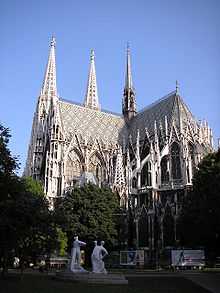Heinrich von Ferstel

Heinrich Freiherr von Ferstel (July 7, 1828, Vienna – 14 July 1883, Grinzing, near Vienna (now a part of Döbling) was an architect who helped build late 19th-century Vienna.
His father Ignaz Ferstel was a bank clerk of Prague. After wavering for some time between the different arts, he finally decided on architecture which he studied at the Academy under Eduard van der Nüll, August Sicard von Sicardsburg, and Rösner. After several years during which he was in disrepute because of his part in the 1848 Revolution, he entered the atelier of his uncle, Stache, where he worked at the votive altar for the chapel of St. Barbara in St. Stephen's Cathedral, Vienna and co-operated in the restoration and construction of many castles, chiefly in Bohemia. Journeys of some length into Germany, Belgium, Holland, and England confirmed him in his tendency towards Romanticism. It was in Italy, however, where he was sent as a bursar in 1854, that he was converted to the Renaissance style of architecture, and his admiration for Bramante. He began to use of polychromy by means of Graffito decoration and terracotta. This device, adapted from the Early Renaissance and intended to convey a fuller sense of life, he employed later in the Austrian Museum of Applied Arts.
While still in Italy he was awarded the prize in the competition for the votive church (Votivkirche) of Vienna (1855) over 74 contestants. He built it between 1856-79. After his death it was proposed by Sir Tatton Sykes as a model for the new Westminster Cathedral in London.[1] Another of Ferstel's monumental works belonging to the same period is the Austro-Hungarian bank in Vienna, in the style of the Early Renaissance (1856–60). The expansion of the city of Vienna enabled Ferstel, with Rudolf Eitelberger, to develop civic architecture along artistic lines (Burgomaster's residence, Stock Exchange 1859). At the same time he had also the opportunity of putting his ideas into practice in a number of private dwellings and villas in Brünn and Vienna.
The more important buildings designed during his later years (passing over the churches at Schonau near Teplitz, really products of his earlier activity) are the palace of Archduke Ludwig Victor, his winter palace in Klessheim, the palace of Prince Johann II of Liechtenstein in the Rossau near Vienna, the palace of the Austro-Hungarian Lloyd's, in Trieste, but above all the Austrian Museum for Applied Art (completed in 1871), with its imposing arcaded court. Next comes the University of Vienna (1871–84). He was also an author of the project of the reconstruction in the Neo-Gothic style the evangelical Church's of Saviour in Bielsko (1881–1882). Through a technical error his design for the Berlin Reichstag building received no award. In 1866 Ferstel was appointed professor at the Polytechnic School, in 1871 chief government inspector of public works and in 1879 was raised to the rank of Freiherr.
Notes
- ↑ Norbert Wibiral; Nikolaus Pevsner (1977). "A Westminster Cathedral Episode". Architectural History (Architectural History, Vol. 20) 20: 63–64,100–101. doi:10.2307/1568352. JSTOR 1568352.
References
- Attribution
-
 This article incorporates text from a publication now in the public domain: Herbermann, Charles, ed. (1913). "Heinrich, Freiherr von Ferstel". Catholic Encyclopedia. Robert Appleton Company.
This article incorporates text from a publication now in the public domain: Herbermann, Charles, ed. (1913). "Heinrich, Freiherr von Ferstel". Catholic Encyclopedia. Robert Appleton Company.
External links
|